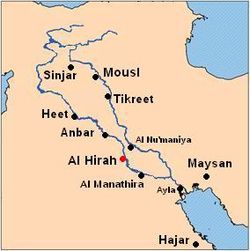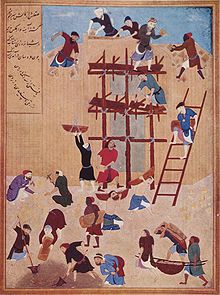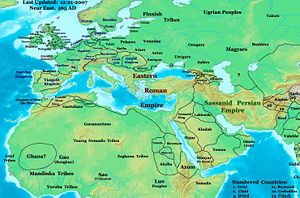- Lakhmids
-
The Lakhmids (Arabic: اللخميون), Banu Lakhm (Arabic: بنو لخم), Muntherids (Arabic: المناذرة), were a group of Arab Christians who lived in Southern Iraq, and made al-Hirah their capital in 266. Poets described it as a Paradise on earth, an Arab Poet described the city's pleasant climate and beauty "One day in al-Hirah is better than a year of treatment". The al-Hirah ruins are located 3 kilometers south of Kufa, on the west bank of the Euphrates. Their descendants today are the Mandharis, who are a prominent tribe who are considered Sheikhs in Iraq, the United Arab Emirates, and the Sultanate of Oman. The Abbabids, another prominent tribe in Yemen and the southern part of The Sultanate of Oman. And the Na'amanis, another Arab tribe in Oman. All of the tribes mentioned before belong to either Ibadhi or Sunni Islam. Some other famous descendants include the Arslans (Arslan meaning Lion in Turkish) which is a very powerful Lebanese family and is a hereditary Druze leadership. It is a princely family.
Contents
History
The Lakhmid Kingdom was founded by the Lakhum tribe that emigrated from Yemen in the 2nd century and ruled by the Banu Lakhm, hence the name given it. The founder of the dynasty was 'Amr, whose son Imru' al-Qais (not to be confused with the famous poet Imru' al-Qais who lived in the 6th century) converted to Christianity. Gradually the whole city converted to that faith.
Imru' al-Qais dreamt of a unified and independent Arab kingdom and, following that dream, he seized many cities in Arabia. He then formed a large army and developed the Kingdom as a naval power, which consisted of a fleet of ships operating along the Bahraini coast. From this position he attacked the coastal cities of Iran (Persia) - which at that time was in civil war, due to a dispute as to the succession - even raiding the birthplace of the Sassanid kings, the province of Pars (Fars).
In 325, the Persians, led by Shapur II, began a campaign against the Arab kingdoms. When Imru' al-Qais realised that a mighty Persian army composed of 60,000 warriors was approaching his kingdom, he asked for the assistance of the Roman Empire. Constantius II promised to assist him but was unable to provide that help when it was needed. The Persians advanced toward al-Hirah and a series of vicious battles took place over al-Hirah and the surrounding cities.
Shapur II crushed the Lakhmid army and captured al-Hirah. He ordered the extermination of its population in retaliation of their raids on Pars. In this, the young Shapur acted much more violently than was normal at the time in order to demonstrate to both the Arab Kingdoms and the Persian nobility his power and authority. Shapur's title in Arabic is Zol 'Aktāf meaning owner of the shoulders, as he pierced the shoulders of his captives and chained them to each other by a rope. He installed Aus ibn Qallam and gave the city autonomy, thus making the kingdom a buffer zone between the Persian Empire's mainland and the territory of other Arabs in the Peninsula.
Imru' al-Qais escaped to Bahrain, taking his dream of a unified Arab nation with him, and then to Syria seeking the promised assistance from Constantius II which never materialized, so he stayed there until he died. With him ended the dream of a united Arab kingdom until after the advent of Islam. When he died he was entombed at al-Nimarah in the Syrian desert.
Imru' al-Qais' funerary inscription is written in an extremely difficult type of script. Recently there has been a revival of interest in the inscription, and controversy has arisen over its precise implications. It is now certain that Imru' al-Qais claimed the title "King of all the Arabs" and also claimed in the inscription to have campaigned successfully over the entire north and centre of the peninsula, as far as the border of Najran.
Two years after his death, in the year 330, a revolt took place where Aus ibn Qallam was killed and succeeded by the son of Imru' al-Qais, 'Amr. Thereafter, the Lakhmids' main rivals were the Ghassanids, who were vassals of the Sassanids' arch-enemy, the Byzantine Empire. The Lakhmid kingdom was a major centre of the Nestorian sect of Christianity which was nurtured by the Sassanids, as it opposed the Orthodox religion of Byzantium.
The Lakhmids remained influential throughout the 6th century. Nevertheless, in 602, the last Lakhmid king, Nu'man III, was put to death by the Sassanid king Khosrau II because of a false suspicion of treason, and the Lakhmid kingdom was annexed. Islam overran the Sassanid Empire in the 7th century. At that point, the city was abandoned and its materials were used to re-construct Kufa, its exhausted twin city.
It is now widely believed that the annexation of the Lakhmid kingdom was one of the main factors behind the Fall of Sassanid dynasty to the Muslim Arabs and the Islamic conquest of Persia, as the Lakhmids agreed to act as spies for the Muslims after being defeated in the Battle of Hira by Khalid ibn al-Walid.[1]
Arab-Persian War
'The Battle of Dhi Qar' (Arabic,يوم ذي قار) was a Pre-Islamic battle fought between Arabs in southern Iraq and a Persian army, c. 609.
According to the Arab historian Abu 'Ubaida (d. 824), Khosrau II was angry with King Numan III for refusing to give him his daughter in marriage, and therefore imprisoned him. Subsequently, Khusraw sent troops to recover the Numan family armor, but Hany bin Masud (Numan's friend) refused, and the Persian forces were defeated at the battle of Dhi Qar, near Al-Hirah, the Lakhmid dynasty's capital. Hirah, sometimes spelled "Hira," was just south of the Iraqi city of Kufa.
Lakhmid Kingdom facts
- al-Hirah was the cradle of the Arabic alphabet.
- It was the birthplace of famous poets like al-Nabighah al-Thubyani, Laqete ibn Ya'amur al-Ayadi, 'Alqama ibn 'Abada and Uday ibn Zaid al-Abbadi. It was visited by other great poets like Tarafah ibn al-'Abd, Amr ibn Kulthum (who killed 'Amr III).
- Sassanid army along with al-Mundhir III ibn al-Nu'man himself and his army defeated the famed Byzantine general Belisarius at the Battle of Callinicum (531).
- After the death of al-Nu'man III, Arabs defeated the Persians in the Battle of Thi-Qar.
- Lakhmids sometimes had good relations with Persians. Bahram V lived in Al-Hirah and was educated at the court of al-Mundhir I, whose support helped him gain the throne after the assassination of his father.
Á
Lakhmid rulers
# Ruler Reign 1 'Amr I ibn Adi 268–295 2 Imru' al-Qays I ibn 'Amr 295–328 3 'Amr II ibn Imru' al-Qays 328–363 4 Aws ibn Qallam (non-dynastic) 363–368 5 Imru' al-Qays II ibn 'Amr 368–390 6 al-Nu'man I ibn Imru' al-Qays 390–418 7 al-Mundhir I ibn al-Nu'man 418–462 8 al-Aswad ibn al-Mundhir 462–490 9 al-Mundhir II ibn al-Mundhir 490–497 10 al-Nu'man II ibn al-Aswad 497–503 11 Abu Ya'fur ibn Alqama (non-dynastic, uncertain) 503–505 12 al-Mundhir III ibn al-Nu'man 503/5–554 13 'Amr III ibn al-Mundhir 554–569 14 Qabus ibn al-Mundhir 569–573 15 Suhrab (Persian governor) 573–574 16 al-Mundhir IV ibn al-Mundhir 574–580 17 al-Nu'man III ibn al-Mundhir 580–602 18 Iyas ibn Qabisah al-Ta'i (non-dynastic)
with Nakirjan (Persian governor)602–611 19 Azadhbeh (Persian governor)
followed by the Muslim conquest of Persia611–633 Descendants
The Lakhmid dynasty had a Prince once called Arslan bin Malek bin Barakat.[citation needed] After the abolishment of the Lakhmid Kingdom of the Hira, the family name of Arslan was given to the descendants of the Kingly dynasty. The Arslan family was sent to the coast of the Lebanon by the Islamic Khalifa in 634 AD and they were responsible of guarding the coast and protecting it. They ruled Beirut for 476 years (from 634 AD till 1110 AD). However, Prince Arslan bin al-Mundhir founded the Principality of Sin-el-Fil in 759 AD in Beirut. The Principality of Sin-el-Fil[citation needed] was the base of the afterwards Principality of Mount Lebanon[citation needed] who was the base of the foundation of Greater Lebanon.[citation needed] The "Arslan dynasty" is still one of the most powerful Lebanese political families, and is now considered[by whom?] to be a hereditary Druze leadership dynasty. The current leader is Prince Talal bin Majeed bin Toufic Arslan (1989–present) whose father was the Lebanese independence hero, and Lebanese minister of defense for over 30 years: Prince Majeed bin Toufic bin Majeed Arslan.
See also
- Prince Talal Arslan
- Kingdom of Araba
- Tanukhids
References
- ^ Iraq After the Muslim Conquest By Michael G. Morony, pg. 233
- History book of Ibn Khaldoun
- History book of Ibn al-Athir
- History book of Ibn Hisham
- Rothstein, Gustav (1899) (in German), Die Dynastie der Lahmiden in al-Hira. Ein Versuch zur arabisch-persischen Geschichte zur Zeit der Sasaniden, Berlin: Reuther & Reichard
- Britannica Encyclopedia
- Bahrain government website "Arabic website"
- Article about al-Hira history "Arabic website"
External links
- Battle of Dhi
- Al Sejel el Arslaneh (the book of the history of the Arslan dynasty)
Categories:- Lakhmids
- Christian tribes of Arabia
- Iraqi people
- Iranian Arab people
Wikimedia Foundation. 2010.



